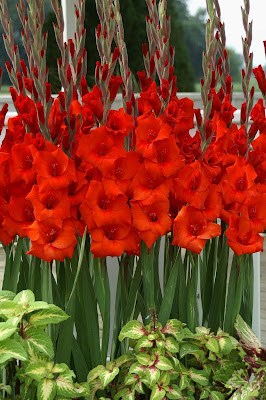As you are planting your summer flower garden, don’t forget to include bulbs, corms and roots. Some examples include gladiolus, dahlias, canna, lilies and tuberous begonias. Often called summer bulbs, these flowers add an exotic touch to the garden. Here are some of the most popular examples:
 |
| Photo Pine Tree Garden Seeds |
Gladiolus is a popular corm, coming in nearly every color, including lime green. Plant the corms 3 inches deep and 6 inches apart in the spring, after danger of frost has passed. During the growing season, the original corm withers and a new corm forms on top of it. The cutting of the flowers does not inhibit the development of the new corm, as long as the leaves are left. As soon as the vegetative top of the plant dies down, dig the corms. Remove the withered corm, and store the new corms in a frost-free location over winter. Avoid a storage place with high temperatures and low humidity.
 |
| Dahlia Show Everett, Washington |
Dahlias come in a wide variety of colors. They usually require support because of their height. Provide support by driving a stake into the ground 12 inches deep and 6 inches behind the root at the time of planting. Dahlias do not tolerate frost, so plant the tuberous roots after all frost possibilities have passed. In the fall when the vegetation is killed by frost, prune back the stalks to 6 inches. Leave the tuberous roots in the ground for two weeks to harden before digging them. Dry the tuberous roots enough to shake off excess soil, and pack in sawdust, perlite or vermiculite and store in a cool, dry place until spring.
 |
| Photo Lowes.com |
Canna flowers come in a wide range of color and the foliage can be green, bronze or variegated. Canna plants thrive in containers, planting beds and also ponds and water gardens. Plant the rhizomes 6 inches deep and 18 inches apart in late spring and after the danger of frost has passed. After frost kills the foliage in fall, dig and store the roots over winter, much the same as dahlias.
 |
| Photo americanmeadows.com |
Lilies are available in several types and in colors ranging from white and yellow to deep red. While lilies are perennial, some do not survive Colorado’s winters. To test hardiness of a particular lily, dig a portion of the plants and pack the rhizomes in sawdust, perlite or vermiculite. Store the rhizomes in a frost-free location during the winter. Replant the stored lilies in the spring. The plants remaining in the garden should be heavily mulched to avoid
winter kill. Plant the lilies to a depth three times the height of the bulb. Easter lilies can also be planted into Colorado gardens with varied success.
 |
| Photo New York Times |
Tuberous begonias range in color from white, yellow and orange to deep red. Flowers are usually double and bloom for a long period. Plant the tuberous begonia roots (which may be up to 1 ½ inches in diameter) 4 inches deep in a partially-shaded area. Tuberous begonias do best in soil with high organic matter that is kept relatively moist. After frost, dig the roots from the ground, pack in sawdust, and store under cool, but frost-free conditions for replanting in the spring.
For more information, check out CSU Extension’s Fact Sheet Spring Planted Bulbs, Corms and Roots. You will be rewarded with a bright display of color and texture in the summer and fall!



